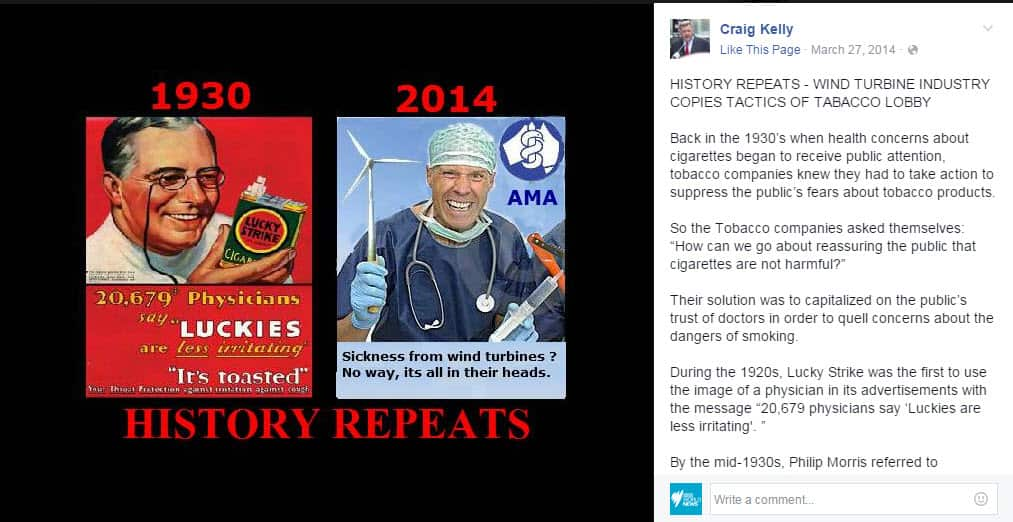Is your child’s digitally-enhanced Barbie doll emanating radiation that will sicken your beloved offspring in 30 years’ time? That was the scenario proposed by Dr Devra Davis, a scientist concerned about the health risks of wireless radiation, in a Facebook post.
The post features a common tactic in efforts to generate unjustified fear and anxiety in people: the exposure of the most cherished and vulnerable members of our society to inescapable and hidden threats - our children.
Dr Davis featured prominently on an episode of Catalyst on Tuesday, titled ‘Wi-Fried?’, which has been criticised for provoking unjustified fear.
My own experience is in the clean energy industry, in particular, wind energy. Over the past 5 years the same tactic - children presented as the victims of an invisible, pervasive and inescapable threat - has been employed as a warning against new wind farms.
Noise in the frequency band between 0 and 20 hertz has been implicated as the cause of ‘wind turbine syndrome’. Just as in the most heart-wrenching moments of ‘Wi-Fried?’, groups propagating the wind turbine syndrome hypothesis have featured imagery of children being placed in peril.
There is research around why environmental factors, like electromagnetic radiation, can spur health fears, and why those fears can translate into symptoms of illness, even in ‘provocation tests’ where there is no wireless signal active.
Focusing on a threat to children can boost the emotional component of a message. It jolts us away from how we’d normally react to a lack of any evidence of harm - namely, that we wouldn’t need to feel fear or anxiety. We still care for our children, but we tune our caution more closely to the views of expert consensus, rather than amplified outliers and shaky predictions.
Another dominant theme in the 'Catalyst’ report was scientific uncertainty. The presenter Maryanne Demasi wrote in The Guardian: “To my mind, 'no evidence of established health risk,' is not the same as saying it’s safe”.
That logic is odd, as it in effect means that every single under-studied phenomenon should be classed as unsafe, which is plainly ridiculous.
In Korea, electric fans have been implicated in ‘fan death’ - no long term studies exist, and this phenomenon has been studied significantly less than exposure to electromagnetic radiation. Yet the same sense of fear and anxiety are not present.
Another tactic used to inspire community anxiety in lieu of strong scientific evidence is a comparison to tobacco, asbestos and thalidomide.
These are potent comparisons - the cumulative death and injury caused by these previously ubiquitous commercial agents is real and horrifying. As you might expect, vaccines, smart meters, wind turbines, mobile phones, GMOs are all compared to these man-made agents. It’s a spurious comparison, but it features heavily in efforts to inspire fear, such as the content in ‘Wi-Fried’.
As you might expect, vaccines, smart meters, wind turbines, mobile phones, GMOs are all compared to these man-made agents. It’s a spurious comparison, but it features heavily in efforts to inspire fear, such as the content in ‘Wi-Fried’.

Liberal Federal Member for Hughes Craig Kelly posted this meme on Facebook in March 2014. Source: Facebook
Though the logic of ‘Wi-Fried?’ is far from solid, wireless technology ticks the boxes for immediate public concern in a way that electric fans and cigarettes do not.
A 2007 government rollout of wireless networking created nervousness around involuntary exposure, and the Catalyst episode taps into a generalised anxiety about the rapid expansion of our digital lifestyles. Pronouncements from authorities about risk and safety are confusing, no matter the subject.
Exploring contentious issues is fine, but the format of ‘Wi-Fried?’ is likely to have created a fair amount of nervousness, particularly in school communities. The potent mix of techniques used in the show has decoupled the reaction from the scientific evidence.
Ketan Joshi is a research and communications professional in the renewable energy industry. He blogs at Some Air.
Share

